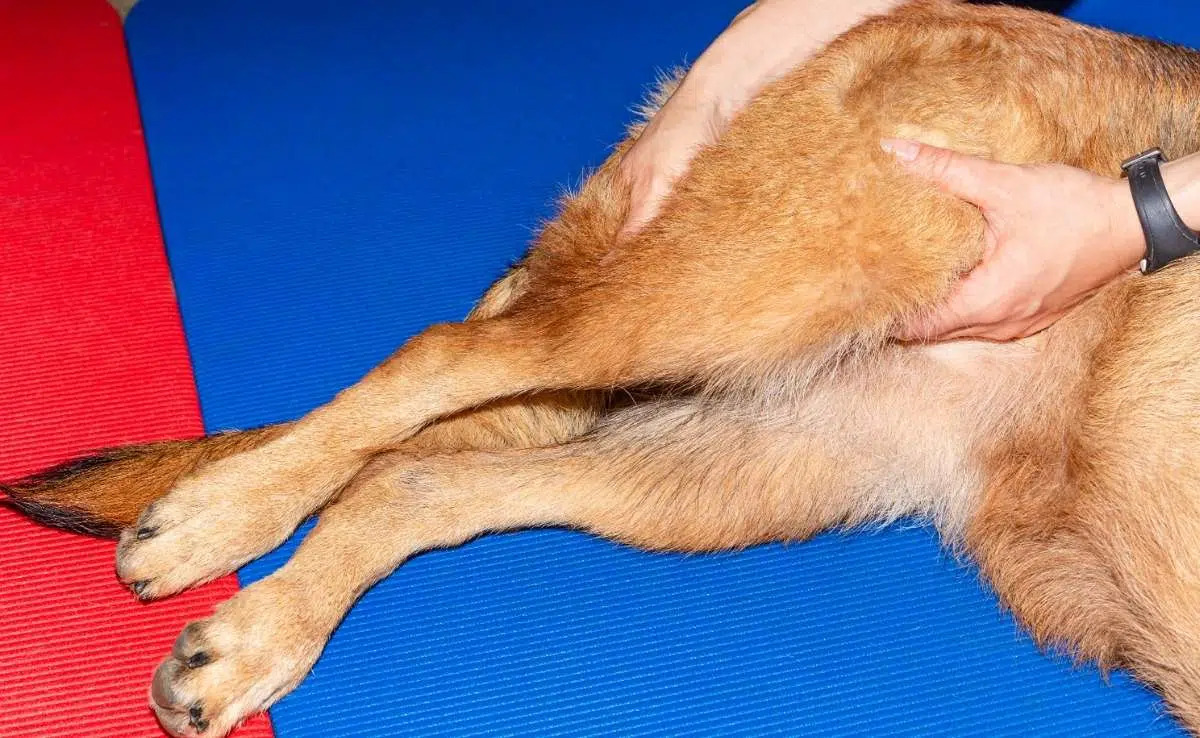Home>Health & Wellness>Common Health Issues>Muscular and Joint Health>What To Do For Dog’s Hip Arthritis


Muscular and Joint Health
What To Do For Dog’s Hip Arthritis
Modified: February 21, 2024
Discover effective strategies for managing your dog's hip arthritis and promoting their muscular and joint health. Learn how to improve your furry friend's quality of life today.
(Many of the links in this article redirect to a specific reviewed product. Your purchase of these products through affiliate links helps to generate commission for Pawsomeoldies.com, at no extra cost. Learn more)
Table of Contents
Introduction
Hip arthritis is a common condition that affects dogs, particularly as they age. Just like humans, dogs can experience joint pain and stiffness due to arthritis, impacting their mobility and overall quality of life. As a responsible pet owner, it's essential to understand the signs, symptoms, and treatment options available for managing hip arthritis in dogs.
Arthritis in a dog's hip joint occurs when the cartilage that cushions the joint wears down over time, leading to inflammation and discomfort. This can result from factors such as genetics, obesity, injury, or simply the wear and tear of daily activities. As a result, the affected dog may experience difficulty in performing regular activities like walking, running, or even standing up.
In this comprehensive guide, we will delve into the various aspects of hip arthritis in dogs, including the signs and symptoms to watch out for, methods of diagnosis, and the wide array of treatment options available. Additionally, we will explore lifestyle changes, exercise regimens, medications, surgical procedures, and alternative therapies that can help manage and alleviate the discomfort associated with hip arthritis in dogs.
Understanding and addressing hip arthritis in dogs is crucial for ensuring their well-being and happiness. By familiarizing yourself with the information provided in this guide, you can take proactive steps to support your furry companion in living a comfortable and active life despite the challenges posed by hip arthritis. Let's embark on this journey to empower ourselves with the knowledge and resources needed to provide the best care for our beloved canine friends.
Understanding Hip Arthritis in Dogs
Hip arthritis, also known as canine hip dysplasia, is a degenerative joint disease that commonly affects dogs, particularly those of larger breeds. This condition occurs when the hip joint undergoes abnormal development, leading to the deterioration of the cartilage and the subsequent inflammation of the joint. As a result, the affected dog experiences pain, stiffness, and reduced mobility in the hip area.
The hip joint is a ball-and-socket joint, where the rounded head of the femur fits into the acetabulum of the pelvis. In a healthy hip joint, the surfaces of the ball and socket are smooth and covered with a layer of cartilage, allowing for smooth and pain-free movement. However, in dogs with hip arthritis, this cartilage becomes worn down over time, leading to friction and discomfort during movement.
Several factors contribute to the development of hip arthritis in dogs. Genetics play a significant role, as certain breeds are predisposed to hip dysplasia due to their genetic makeup. Large and giant breeds, such as German Shepherds, Labrador Retrievers, and Great Danes, are particularly susceptible to this condition. Additionally, rapid growth and excessive weight gain during puppyhood can exacerbate the risk of hip dysplasia in these breeds.
Injury and trauma to the hip joint can also contribute to the development of arthritis in dogs. Activities that place excessive strain on the hip joint, such as jumping from heights or engaging in high-impact exercises, can lead to joint damage and subsequent arthritis. Furthermore, obesity can exacerbate hip arthritis in dogs, as the additional weight places increased pressure on the hip joint, accelerating the degenerative process.
Understanding the underlying causes and mechanisms of hip arthritis in dogs is crucial for pet owners. By recognizing the predisposing factors and risk elements associated with this condition, pet owners can take proactive measures to mitigate the impact of hip arthritis on their canine companions. Through informed awareness and proactive management, pet owners can provide the necessary support and care to enhance the quality of life for dogs affected by hip arthritis.
Signs and Symptoms
Recognizing the signs and symptoms of hip arthritis in dogs is essential for early detection and intervention. While dogs may not be able to verbally communicate their discomfort, they exhibit various behavioral and physical indicators that can signal the presence of hip arthritis. By being attentive to these signs, pet owners can promptly seek veterinary care and implement appropriate measures to alleviate their furry companion's discomfort.
Behavioral Changes
Dogs with hip arthritis often display noticeable changes in their behavior. They may become less active, reluctant to engage in physical activities they once enjoyed, or exhibit signs of discomfort when moving. Reluctance to climb stairs, jump onto furniture, or participate in playtime can indicate underlying joint pain and stiffness. Additionally, affected dogs may demonstrate irritability or restlessness, as the discomfort associated with hip arthritis can impact their overall demeanor and temperament.
Altered Gait and Mobility
Observing changes in a dog's gait and mobility can provide valuable insights into the presence of hip arthritis. Dogs with this condition may exhibit a stiff or awkward gait, favoring one hind leg over the other. They may also display a noticeable reluctance to bear weight on the affected leg, leading to a limp or an uneven distribution of weight while walking. Furthermore, decreased agility and difficulty rising from a lying or sitting position are common indicators of hip arthritis in dogs.
Read more: What Does Laser Do For Arthritis In Dogs?
Muscle Atrophy
Muscle atrophy, or the loss of muscle mass, in the hindquarters can be a visible manifestation of hip arthritis in dogs. The affected leg may appear thinner or weaker due to reduced muscle tone resulting from decreased physical activity and mobility. This can be observed through visual and tactile cues, as the muscles in the hindquarters may appear less defined and firm compared to those of the unaffected leg.
Vocalization and Signs of Pain
Dogs experiencing hip arthritis may vocalize or exhibit signs of discomfort when moving or being touched in the hip area. Whimpering, yelping, or exhibiting signs of pain when the hip joint is manipulated or touched can indicate the presence of joint discomfort. Additionally, dogs may display signs of stiffness and difficulty when transitioning from lying down to standing, often accompanied by audible signs of discomfort.
Postural Changes
Changes in a dog's posture can also provide valuable clues regarding the presence of hip arthritis. Dogs may assume a hunched or rigid posture, attempting to alleviate pressure on the affected hip joint. This altered posture can be observed during standing, sitting, or lying down, as dogs may attempt to minimize the discomfort associated with hip arthritis by adjusting their body position.
By being attuned to these signs and symptoms, pet owners can promptly seek veterinary evaluation and guidance. Early detection and intervention are crucial for effectively managing hip arthritis in dogs, ultimately improving their comfort and quality of life.
Diagnosing Hip Arthritis
Diagnosing hip arthritis in dogs involves a comprehensive assessment that combines clinical evaluation, imaging techniques, and, in some cases, laboratory tests. Veterinary professionals utilize a multi-faceted approach to accurately diagnose hip arthritis and formulate an effective treatment plan tailored to the individual needs of the affected dog.
Clinical Evaluation
The initial step in diagnosing hip arthritis involves a thorough clinical evaluation by a veterinarian. During this assessment, the veterinarian examines the dog's gait, mobility, and overall musculoskeletal condition. They observe the dog's movement patterns, looking for signs of lameness, stiffness, or discomfort during physical activities. Additionally, the veterinarian may palpate the hip joint to assess for pain, swelling, or abnormalities in the joint structure. Observing the dog's posture, muscle tone, and range of motion in the hip joint provides valuable insights into the presence and severity of hip arthritis.
Imaging Techniques
Imaging plays a pivotal role in diagnosing hip arthritis in dogs. X-rays, or radiographs, are commonly employed to visualize the hip joint and assess for signs of degeneration, joint irregularities, and the presence of osteoarthritis. X-rays provide detailed images of the hip joint, enabling veterinarians to evaluate the extent of cartilage loss, bone spurs, and joint deformities. Additionally, advanced imaging modalities such as computed tomography (CT) scans or magnetic resonance imaging (MRI) may be utilized for a more comprehensive assessment of the hip joint, particularly in complex or challenging cases.
Laboratory Tests
While hip arthritis is primarily diagnosed through clinical evaluation and imaging, laboratory tests may be employed to rule out other potential causes of joint discomfort. Blood tests, including complete blood counts and serum chemistry panels, can help assess the overall health status of the dog and identify any underlying systemic conditions that may contribute to joint inflammation. Additionally, joint fluid analysis, obtained through joint aspiration, may be performed to evaluate for signs of inflammation, infection, or the presence of abnormal joint fluid indicative of arthritis.
Collaborative Approach
Diagnosing hip arthritis in dogs often involves a collaborative approach between the pet owner, the veterinarian, and, in some cases, veterinary specialists. Pet owners play a crucial role in providing insights into their dog's behavioral changes, mobility issues, and overall well-being, contributing valuable information to the diagnostic process. By working closely with the veterinary team, pet owners can actively participate in the diagnostic journey, facilitating a comprehensive understanding of their dog's condition and the subsequent development of a tailored treatment plan.
By employing a combination of clinical evaluation, imaging techniques, and collaborative communication, veterinarians can accurately diagnose hip arthritis in dogs, laying the foundation for effective treatment and management strategies. Early and precise diagnosis is pivotal in initiating timely interventions to alleviate discomfort and enhance the quality of life for dogs affected by hip arthritis.
Treatment Options
The treatment of hip arthritis in dogs encompasses a diverse array of options aimed at alleviating discomfort, improving mobility, and enhancing the overall quality of life for affected canine companions. Veterinary professionals employ a multi-faceted approach, tailoring treatment strategies to address the specific needs and severity of hip arthritis in individual dogs. From lifestyle modifications and physical therapy to medications, surgical interventions, and alternative therapies, the treatment options available offer comprehensive solutions to manage hip arthritis in dogs.
Lifestyle Changes for Managing Hip Arthritis
Implementing lifestyle modifications is a fundamental aspect of managing hip arthritis in dogs. Maintaining a healthy weight through a balanced diet and regular exercise is crucial, as excess weight exacerbates joint strain and discomfort. Providing a supportive and comfortable environment, including orthopedic bedding and ramps to minimize jumping, can alleviate pressure on the hip joint. Additionally, modifying daily activities to reduce high-impact movements and incorporating gentle exercise regimens tailored to the dog's condition can contribute to improved joint function and mobility.
Exercise and Physical Therapy
Exercise and physical therapy play a pivotal role in managing hip arthritis in dogs. Low-impact activities, such as swimming and leash walking, help maintain muscle strength and joint flexibility without placing excessive strain on the hip joint. Physical therapy modalities, including therapeutic exercises, massage, and hydrotherapy, aid in improving range of motion, reducing stiffness, and enhancing overall musculoskeletal function. These interventions promote joint health and support the dog's physical well-being.
Medications and Supplements
Veterinary-prescribed medications and supplements are commonly utilized to manage hip arthritis in dogs. Non-steroidal anti-inflammatory drugs (NSAIDs) provide pain relief and reduce joint inflammation, improving the dog's comfort and mobility. Additionally, joint supplements containing glucosamine, chondroitin, and omega-3 fatty acids support joint health and cartilage integrity, potentially slowing the progression of arthritis and enhancing joint lubrication.
Read more: What Age Do Dogs Get Arthritis
Surgical Options
In cases of advanced hip arthritis or severe joint deterioration, surgical interventions may be considered. Total hip replacement and femoral head ostectomy are surgical procedures aimed at alleviating pain and restoring joint function. These interventions are tailored to the individual dog's condition and are performed by veterinary orthopedic specialists to address the specific needs of the affected hip joint.
Alternative Therapies
Complementary and alternative therapies offer additional avenues for managing hip arthritis in dogs. Acupuncture, chiropractic care, and laser therapy can provide pain relief, reduce inflammation, and promote overall well-being. These holistic approaches, when integrated with conventional treatments, contribute to a comprehensive and holistic management strategy for hip arthritis in dogs.
By integrating these diverse treatment options, veterinary professionals and pet owners can collaborate to develop a tailored and effective treatment plan for dogs affected by hip arthritis. Each modality plays a crucial role in addressing the multifaceted aspects of hip arthritis, ultimately enhancing the comfort, mobility, and quality of life for canine companions facing this challenging condition.
Lifestyle Changes for Managing Hip Arthritis
Implementing lifestyle changes is a fundamental aspect of managing hip arthritis in dogs. These modifications are aimed at alleviating discomfort, improving mobility, and enhancing the overall quality of life for affected canine companions. By incorporating specific adjustments into the dog's daily routine and environment, pet owners can proactively support their furry friends in coping with the challenges posed by hip arthritis.
Maintaining a healthy weight through a balanced diet and regular exercise is crucial for dogs with hip arthritis. Excess weight exacerbates joint strain and discomfort, leading to increased pain and reduced mobility. By working with a veterinarian to develop a tailored diet plan and portion control, pet owners can help their dogs achieve and maintain an optimal body condition. Additionally, engaging in regular, low-impact exercise, such as leash walking and controlled play sessions, supports weight management and overall joint health.
Creating a supportive and comfortable environment is essential for dogs with hip arthritis. Providing orthopedic bedding that offers adequate support and cushioning for the joints can alleviate pressure on the hips, especially during rest and sleep. Moreover, incorporating ramps or steps to access elevated surfaces, such as beds or sofas, reduces the need for jumping, minimizing stress on the hip joints. These environmental modifications contribute to a more comfortable and joint-friendly living space for dogs with hip arthritis.
Modifying daily activities to reduce high-impact movements is beneficial for managing hip arthritis. Avoiding activities that place excessive strain on the hip joints, such as jumping or rough play, helps minimize discomfort and potential joint damage. Instead, incorporating gentle exercise regimens tailored to the dog's condition, such as controlled walks and low-impact games, supports joint mobility and muscle strength without exacerbating existing discomfort.
Incorporating these lifestyle changes into the daily routine of dogs with hip arthritis empowers pet owners to actively contribute to the well-being and comfort of their furry companions. By focusing on weight management, creating a supportive environment, and modifying daily activities, pet owners play a pivotal role in enhancing the overall quality of life for dogs facing the challenges of hip arthritis.
Exercise and Physical Therapy
Exercise and physical therapy play a pivotal role in managing hip arthritis in dogs. These interventions are designed to improve joint mobility, maintain muscle strength, and alleviate discomfort, ultimately enhancing the overall quality of life for affected canine companions.
Low-impact activities are particularly beneficial for dogs with hip arthritis. Swimming, often referred to as hydrotherapy for dogs, provides a non-weight-bearing exercise that promotes joint movement without placing excessive strain on the hips. The buoyancy of water reduces the impact on the joints while allowing for a full range of motion, making it an ideal form of exercise for dogs with arthritis. Additionally, leash walking on even surfaces helps maintain muscle tone and joint flexibility without subjecting the hips to high-impact movements.
Physical therapy modalities, including therapeutic exercises and massage, are tailored to address the specific needs of dogs with hip arthritis. Therapeutic exercises focus on improving joint range of motion, strengthening supportive muscles, and enhancing overall mobility. These exercises are customized to the individual dog's condition, taking into account factors such as age, severity of arthritis, and overall physical health. Furthermore, massage therapy aids in reducing muscle tension, promoting circulation, and alleviating discomfort in the hip area. Gentle, targeted massage techniques can provide relief from stiffness and enhance the dog's overall comfort.
Incorporating physical therapy into the management of hip arthritis requires a collaborative approach between pet owners and veterinary professionals. Under the guidance of a veterinarian or certified canine rehabilitation therapist, pet owners can learn specific exercises and techniques to implement at home, extending the benefits of physical therapy beyond formal sessions. This collaborative approach empowers pet owners to actively participate in their dog's care, contributing to the ongoing management of hip arthritis through consistent exercise and physical therapy regimens.
By integrating low-impact activities and targeted physical therapy, pet owners can support their dogs in maintaining joint mobility, muscle strength, and overall physical well-being. These interventions, when incorporated into a comprehensive treatment plan, contribute to the holistic management of hip arthritis in dogs, ultimately enhancing their comfort and quality of life.
Read more: What Would A Service Dog Do For Arthritis?
Medications and Supplements
Medications and supplements play a crucial role in the comprehensive management of hip arthritis in dogs, offering targeted relief from pain and inflammation while supporting joint health and mobility. Veterinary-prescribed medications and supplements are tailored to address the specific needs of dogs affected by hip arthritis, providing a multifaceted approach to alleviate discomfort and enhance overall well-being.
Non-steroidal anti-inflammatory drugs (NSAIDs) are commonly prescribed to dogs with hip arthritis to alleviate pain and reduce joint inflammation. These medications offer effective relief from discomfort, allowing affected dogs to experience improved mobility and enhanced quality of life. By targeting the underlying inflammation within the hip joint, NSAIDs help mitigate the discomfort associated with arthritis, enabling dogs to engage in daily activities with greater ease and comfort.
In addition to NSAIDs, joint supplements containing key ingredients such as glucosamine, chondroitin, and omega-3 fatty acids are integral components of the treatment regimen for hip arthritis in dogs. These supplements support joint health, promote cartilage integrity, and aid in reducing the progression of arthritis. Glucosamine and chondroitin are essential building blocks for cartilage and joint fluid, contributing to improved joint lubrication and resilience. Omega-3 fatty acids possess anti-inflammatory properties, further supporting joint health and reducing the impact of arthritis-related inflammation.
The combination of medications and supplements offers a comprehensive approach to managing hip arthritis, addressing both the symptomatic relief of pain and inflammation and the underlying support for joint health and function. Veterinary professionals work closely with pet owners to determine the most suitable medications and supplements based on the individual dog's condition, ensuring a tailored and effective treatment plan.
By integrating medications and supplements into the overall management of hip arthritis, pet owners can actively contribute to their dog's comfort and well-being. These targeted interventions, when combined with lifestyle modifications, exercise, and other treatment modalities, form a holistic approach to supporting dogs affected by hip arthritis, ultimately enhancing their mobility and quality of life.
Surgical Options
In cases of advanced hip arthritis or severe joint deterioration, surgical interventions offer viable solutions to alleviate pain and restore joint function in dogs. These surgical options are tailored to address the specific needs of individual dogs, providing targeted relief and improved mobility. Veterinary orthopedic specialists play a pivotal role in evaluating the suitability of surgical interventions and guiding pet owners through the decision-making process.
Total hip replacement (THR) stands as a transformative surgical procedure for dogs with advanced hip arthritis. This procedure involves the removal of the damaged hip joint and its replacement with a prosthetic implant, effectively restoring joint function and alleviating pain. THR offers long-term benefits, enabling dogs to regain mobility and engage in physical activities with reduced discomfort. The success of THR in dogs with hip arthritis has significantly enhanced their quality of life, allowing them to enjoy an active and pain-free existence.
Femoral head ostectomy (FHO) represents another surgical option for managing hip arthritis in dogs. This procedure involves the removal of the femoral head, the spherical end of the femur that forms the hip joint. By eliminating the damaged or diseased femoral head, FHO eliminates the source of pain and discomfort, promoting the formation of a false joint that enables improved mobility. FHO is particularly beneficial for smaller dogs or those with specific anatomical considerations, offering a viable alternative to total hip replacement.
The decision to pursue surgical intervention for hip arthritis in dogs involves careful consideration of the dog's overall health, the severity of arthritis, and the potential benefits of surgery. Veterinary orthopedic specialists collaborate closely with pet owners to assess the suitability of surgical options, providing comprehensive guidance and support throughout the decision-making process. By weighing the potential risks and benefits of surgical interventions, pet owners can make informed decisions that align with the best interests of their canine companions.
By integrating surgical options into the management of hip arthritis, veterinary professionals and pet owners can explore transformative solutions to alleviate pain and enhance mobility for dogs facing the challenges of advanced arthritis. These surgical interventions, when carefully considered and implemented, offer the potential for significant improvement in the comfort and quality of life for dogs affected by hip arthritis.
Alternative Therapies
In addition to conventional treatment modalities, alternative therapies offer valuable avenues for managing hip arthritis in dogs. These holistic approaches, when integrated with traditional treatments, contribute to a comprehensive and multifaceted strategy aimed at enhancing the comfort and well-being of affected canine companions.
Acupuncture:
Acupuncture, a key component of traditional Chinese medicine, has gained recognition as a beneficial therapy for dogs with hip arthritis. By stimulating specific points on the body with thin needles, acupuncture promotes pain relief, reduces inflammation, and enhances overall well-being. The strategic placement of acupuncture needles triggers the release of endorphins, the body's natural pain-relieving hormones, providing relief from discomfort associated with hip arthritis. Additionally, acupuncture supports improved circulation and the release of anti-inflammatory mediators, contributing to the reduction of joint inflammation and the promotion of joint health.
Chiropractic Care:
Chiropractic care for dogs with hip arthritis focuses on the alignment and mobility of the spine and musculoskeletal system. Through gentle adjustments and manipulations, chiropractic practitioners aim to alleviate joint stiffness, improve mobility, and enhance overall musculoskeletal function. By addressing potential misalignments and imbalances, chiropractic care supports the dog's physical well-being, contributing to improved comfort and mobility. Additionally, chiropractic interventions aid in reducing compensatory strain on other joints, promoting a more balanced and comfortable posture for dogs affected by hip arthritis.
Laser Therapy:
Laser therapy, also known as photobiomodulation, utilizes specific wavelengths of light to stimulate cellular activity and promote tissue healing. In the context of hip arthritis, laser therapy offers targeted relief from pain and inflammation. The application of therapeutic laser energy to the affected hip joint enhances circulation, reduces swelling, and accelerates the body's natural healing processes. This non-invasive and painless modality provides a valuable adjunct to traditional treatments, offering dogs with hip arthritis a non-pharmacological approach to managing discomfort and promoting joint health.
By incorporating these alternative therapies into the overall management of hip arthritis, pet owners and veterinary professionals can expand the spectrum of care available to affected dogs. These holistic interventions, when integrated with conventional treatments, contribute to a comprehensive and individualized approach to supporting dogs affected by hip arthritis, ultimately enhancing their comfort, mobility, and overall quality of life.
Conclusion
In conclusion, the management of hip arthritis in dogs encompasses a multifaceted approach aimed at alleviating discomfort, improving mobility, and enhancing the overall quality of life for affected canine companions. By integrating lifestyle modifications, exercise regimens, medications, surgical interventions, and alternative therapies, veterinary professionals and pet owners collaborate to develop tailored treatment plans that address the specific needs of individual dogs.
Recognizing the signs and symptoms of hip arthritis, such as altered gait, behavioral changes, and muscle atrophy, empowers pet owners to seek timely veterinary evaluation and intervention. Through a comprehensive diagnostic process involving clinical evaluation and imaging techniques, veterinarians accurately assess the severity of hip arthritis, laying the foundation for targeted treatment strategies.
Lifestyle changes, including weight management, environmental modifications, and activity adjustments, form the cornerstone of managing hip arthritis in dogs. By creating a supportive and joint-friendly environment and incorporating low-impact exercise and physical therapy, pet owners actively contribute to their dog's well-being.
The integration of medications, such as NSAIDs, and joint supplements supports symptomatic relief and joint health, enhancing the overall comfort and mobility of dogs with hip arthritis. In cases of advanced arthritis, surgical options, including total hip replacement and femoral head ostectomy, offer transformative solutions to alleviate pain and restore joint function.
Furthermore, alternative therapies, such as acupuncture, chiropractic care, and laser therapy, complement traditional treatments, providing additional avenues for pain relief and joint support.
By embracing a holistic and collaborative approach to managing hip arthritis in dogs, veterinary professionals and pet owners work together to enhance the comfort, mobility, and overall well-being of affected canine companions. Through proactive awareness, early intervention, and comprehensive treatment strategies, dogs with hip arthritis can continue to lead active, comfortable, and fulfilling lives, supported by the unwavering dedication of their caregivers.










